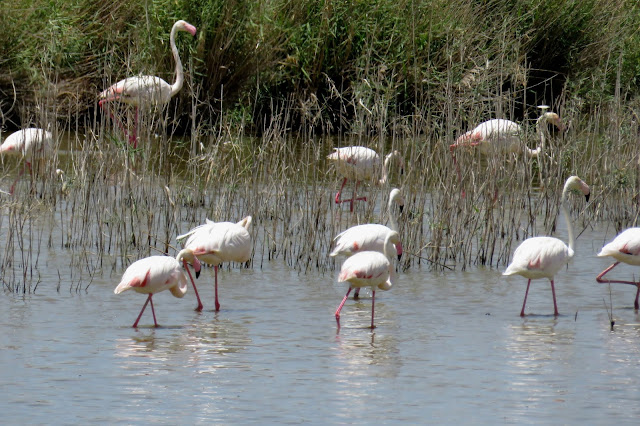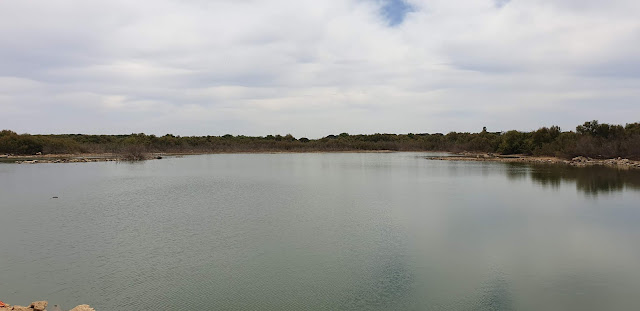We caught an early flight out of Gatwick on a dull Sunday
morning and arrived under three hours later in a sunny Seville. Birding was under way before Shaun, David and
I had even reached the hire car with Pallid Swifts flying around us at head
height and squeezing into tiny gaps in the conduit under the concrete roof of
the car park. House Martins and House Sparrows were similarly occupied with
nesting here. A glance up and a lone Glossy Ibis randomly flew over and
Spotless Starlings were moving about.
 |
| Crossing the Spanish coast - Picos De Europa I believe |
 |
| And low into Seville |
 |
| Palm Sparrow |
And so, out of town and on the road with White Storks,
Raven, Iberian Grey shrikes, Black Kites and Magpies quickly added to the list
before our first stop at Laguna la Mejorada where Western Olivaceous Warbler
was our quarry.
After finding the right track we soon picked up Fan-tailed
and Sardinian Warblers from the car while Whiskered Terns hawked over the small
cultivated plots with Black Kites for company. Crested Larks scurried along the
road in front and there were four hirundines and two Swifts to keep an eye on.
 |
| Black Kite |
A song to the left enforced a stop and our first bonus was
found singing from a fence line – a male Bushchat. This was a target species for the trip but
there are by no means easy and so to stumble on one was great news. He let us
get out and watch before darting off across a field into an olive grove. So
much richer that the grey brown backed Lesvos birds that I had seen in May and
to my ear the song sounded different with notes not as separated and lacking
the whistle that I am familiar with.. This one had a few tail feathers missing
but we did not mind.
 |
| Bushchat |
 |
| Bushchat |
It was only a few yards to the spot we had been given for
the Olis around an old quarry and one
was immediately audible before we pulled over and soon superb views were beign
had of this heavier, chunkier set version of their Eastern counterparts. The
bird actually felt more like a subdued Icterine Warbler to me and behaved in a
more typically clumsy ‘fall of the branch’ kind of way. The bill felt bigger
and broader and the bird more deeply coloured. They were calling continuously
and even this sounded louder and harsher than EOW while the song was not as
cyclical and had more grating notes within it.
 |
| WOW habitat |
 |
| WOW - the best I could get - just too far and the light was actually quite poor |
 |
| However, unbeknown to us, Russ Sherriff was just a few miles away in Seville itself and got these superb images that I think are worth sharing just to illustrate how strikingly different to Eastern OW these birds appear |
Feeling very pleased with our efforts we ambled on and ended
up with 11 WOWs including dependent youngsters. Greenfinches wheezed and two
Common Waxbills popped up before zipping away.
The pit itself was full of
resting and probably nesting herons with Cattle Egrets in a big heap and
Littles and Great Whites dotted amongst them while several Spoonbills, Glossy
Ibis and Black-winged Stilts fed along the margins. With them was a single
Sacred Ibis which although presumably from the remnants of the French
population was still a good find and resulted in a description having to be
done for the Spanish committee as there are not many records.
 |
| Cattle Egrets |
 |
| Moorhen, Spoonbill, Great White Egret and Sacred Ibis |
 |
| Spoonbill |
 |
| Whiskered Tern |
 |
| Glossy Ibis |
More Whiskered
Terns were perched up on a submerged tree and both Lesser Black-backed and
Yellow-legged Gulls were present. Little Ringed Plovers were calling and every now and then a
Collared Pratincole would gracefully fly through.
 |
| Collared Pratincole |
A sandy Short-toed Lark
chirped behind us and amazingly a second Bushchat appeared and showed
incredibly well but like all encounters, they seldom stay still and it was soon
on the move again. Once again the colour
of the upperparts was quite striking.
 |
| Bushchat |
A couple of Lesser Emperors zoomed around and four male
Banded Groundlings with their striking wings quartered mere inches from the
dusty path. We left with the sound of many Turtle Doves purring all around us
and Bee-eaters up above.
It did not take too long to get out into open farmland and
eventually the rice paddies, sunflower fields and rows of young cotton plants
of Brazo del Este and we spent the next few hours working our way up and down
the dusty, public service roads that provide access for farmers and birders
alike.
It was superb with the avifauna dependent on the development
of the rice in each paddy. Some were
covered in Glossy Ibis and Stilts with a smattering of Redshank and Black-tailed
Godwits while other had groups of tuber loving Purple Gallinules looking like
the mega moorhens they are.
 |
| Glossy Ibis |
 |
| Glossy Ibises |
 |
| Black-winged Stilt |
 |
| Purple Gallinules |
 |
| Purple Gallinule |
 |
| Purple Gallinule and Mallard |
 |
| Purple Gallinule |
Whiskered Terns were breeding in the reeded areas of the
oxbow lakes that the road we were on bisected and Collared Pratincoles hawked
with the terns and hirundines over the more mature fields. Lapwings, Ruff and
Avocet were added to the wader list and Purple Herons were liberally scattered
about with plenty of Grey Herons, Cattle and Little Egrets and the odd
Spoonbill, a single Squacco and about 100 Greater Flamingos.
 |
| Whiskered Tern |
 |
| Whiskered Tern |
 |
| Whiskered Tern and two Mega Goldfinches |
 |
| Whiskered Tern |
 |
| Squacco |
 |
| Purple Heron |
 |
| Greater Flamingos |
Night Herons popped up every now and then and were even seen
perching on the telegraph wires with Whiskered Terns! The main flood management gates we passed had
seven Night Herons standing around on the walls and railing although how they
were seeing anything in the rushing waters I am not sure but it did allow us to
get very close without disturbing their concentration.
Black Kites and Marsh Harriers cruised about along with
Kestrels and a dashing Hobby that had a go at a Black-winged Stilt. The reed and willow fringed channels not only
hid Gallinules but Fan-tailed, Reed and Western Olis while one of the
oxbows had five reeling Savi’s and three Great Reeds while male Iberian Yellow
Wagtails with their rasping accents displayed from the a variety of vantage
points.
These reeds also held colonies of nesting Black-headed
Weavers; our second naturalised passerine of the day. We mostly encountered olive-yellow females
who seemed to like foraging in the thistles alongside the tracks but a few
gaudy oriole-yellow and black males were seen and heard but rarely perched up
long for a shot. Their nests were a
tight ball of woven reed quite low down in their chosen patch and there were
several fresh green ones amongst those that had already turned a golden brown.
Interestingly we also found some House Sparrow nests jammed
into the forks of some of the Eucalyptus trees – a sight I have so very rarely
seen back home.
 |
| Black-headed
Weaver |
Short-toed Larks scurried ahead and at one of our first
stops we were lucky enough to see three Lesser Short-toeds on the track as well
which was a bonus.
With time pushing on and a good two hours to our Air B&B
in Portugal we hit the road. Lunch had still not occurred and being a Sunday,
everything in Spain was shut so a diversion was needed and after we at least
managed to pick up some crisps and cold water from a tiny petrol station along
with our first Iberian Magpies, we veered west along the coast and into
Portugal were we aimed for Lidls in Castro Marim where we stocked up on
provisions that included the joyousness of a Portuguese Tart actually in
Portugal...
 |
| Castro Marim |
 |
| Portuguese Tart |
Little and Sandwich Terns
were added as we queued to get back to the bridge into Spain before driving
north and re-crossing the Rio Guadiana at Pomarao to our cottage in the tiny
narrow streeted village of Bens just a few miles over the border.
 |
| Heading back into Spain |
 |
| Rio Guadiana at Pomarao |
 |
| Rio Guadiana at Pomarao from Portugal |
We decamped and cracked open a beer or two and put the
dinner on with sound of Iberian Magpies wheezing in the gardens and flying
around in chattering groups on shining blue wings. This was my new bird for the trip and
undoubtedly the easiest to see. I have
just never been to the right part of Spain before and never to Portugal at all.
 |
| Our abode in Bens |
 |
| Iberian Magpies |
 |
| Not bad views from the kitchen window... |
Short-toed and Crested Larks sung up above and Iberian
Shrikes in pairs looked for a late evening snack and as the light slowly turned
to gold flocks of Spotless Starlings drifted over to roost along with our first
Carrion Crows and Stone Curlews could be heard above the sound of crickets
mournfully calling from the fields.

 |
| Spotless Starlings |
 |
| Red-rumped Swallow |
Sleep came easy...






































































You have managed to post far more photos than I do, well done! Good to see a horse make the shortlist too. I am inspired to do this trip, it sounds great and extremely easy, and I've not seen Bushchat.
ReplyDeleteand sorry for the tardy response... thank you Jono. It was magic... and yes, you may have noticed the odd horse or two makes it into my posts.
ReplyDelete